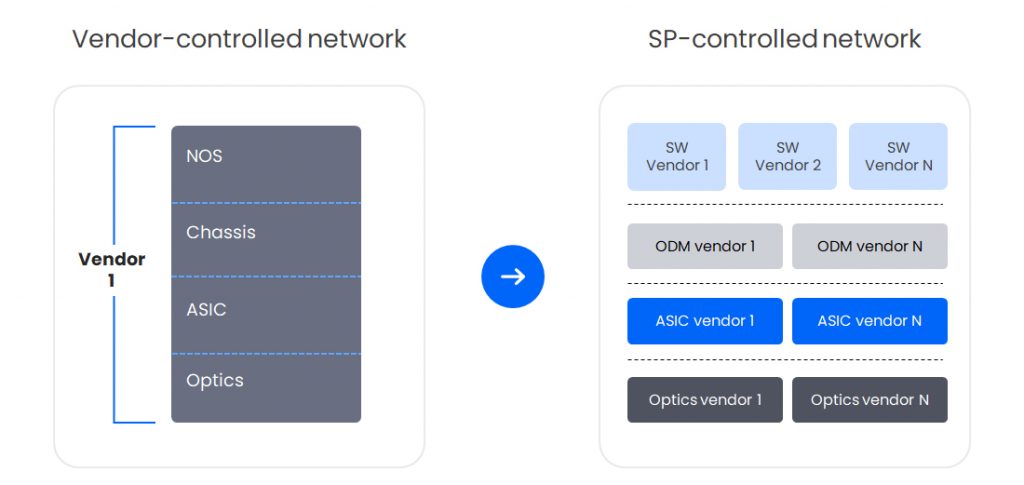|
Getting your Trinity Audio player ready...
|
However, a new trend is emerging led by tier-1 operators – the disaggregation of network elements – which promises to shift the balance of power back into the hands of SPs. This blog post delves into this evolving landscape, examining how disaggregation is transforming vendor selection and empowering SPs.
New vendor selection scheme for network elements
Historically, SPs have relied on integrated/monolithic solutions from established vendors. These solutions often come as a package deal in which hardware is coupled with proprietary software. While such solutions offer reliability and support, this approach has its drawbacks. It limits flexibility, ties SPs to specific vendors (vendor lock-in), and often comes with a premium price tag. Moreover, innovation progresses at the pace of the vendor, not the SP.

Network disaggregation separates the hardware from the software in network elements, allowing SPs to extend their vendor selection criteria beyond the traditional chassis-based parameters of reliability and support. With disaggregation, SPs gain more control over their network architecture – from the network operating system (NOS) and chassis hardware, all the way to ASIC and optics – multiple vendors and multiple mixes. SPs are less dependent on a single vendor’s roadmap and can innovate and adapt more rapidly to market changes. This shift is not just technological but also strategic, altering how SPs plan and execute their long-term networking strategies.
Different flavors of network disaggregation
The network disaggregation paradigm shift is not just a single adjustment but a comprehensive reimagining of network architecture across multiple domains. Disaggregation breaks the monolithic models of the past, presenting a more modular and flexible framework.
Here are few flavors of disaggregation that are paving the way for this transformation:

Vertical disaggregationis where the journey begins. By separating software sourcing from hardware sourcing, operators are no longer handcuffed to the constraints of proprietary systems. This separation allows them to source best-in-class hardware and pair it with advanced software solutions that best meet their needs. The result is a surge in innovation as software development can proceed at its own pace, unrestricted by hardware release cycles. It also opens the door to more competitive pricing and gives operators the agility to respond to market changes with greater speed and flexibility.
Horizontal disaggregationtakes the concept further by dividing network functions (NFs) and workloads optimally across the infrastructure. This approach can lead to a more efficient distribution of resources and an improved quality of service. By strategically placing NFs where they can operate most effectively, operators can enhance performance and scale specific parts of the network independently from others. This fine-tuning capability is crucial for managing the varying demands of modern network services.
Lastly, multi-level disaggregationoffers a multi-faceted approach by allowing multiple network functions to interact with various hardware elements sourced from different suppliers. This multi-level approach not only enhances the flexibility of NF deployment but also mitigates risks associated with vendor lock-in. It enables operators to build a more resilient and adaptive network by combining the best hardware and software elements from a diverse supplier ecosystem.
Moving from vendor centric to service provider centric
The move towards disaggregation in network routing elements represents a significant shift in the telecommunications industry for service providers. It’s a move from a vendor-centric model to an SP-centric one. This change offers numerous benefits, including increased flexibility, reduced costs, and a faster pace of innovation. As the industry continues to evolve, it will be interesting to observe how these changes play out – and how SPs leverage this power and control to their advantage.
Download
Introducing DriveNets Network Cloud




